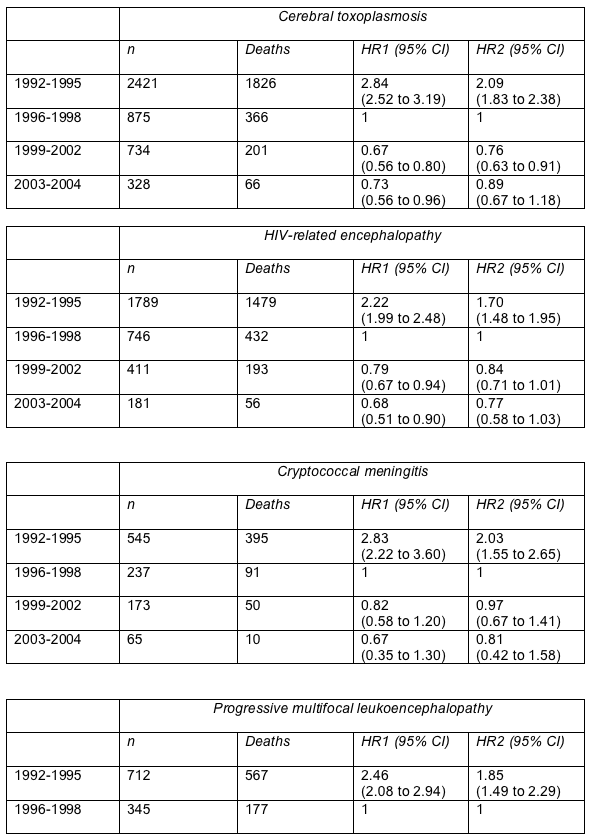 |
 |
 |
| |
Good News and Bad News on Survival With Neurologic AIDS
|
| |
| |
11th European AIDS Conference
October 24-27, 2007
Madrid
Mark Mascolini
Analysis of the French Hospital Database on HIV showed that survival after diagnosis of toxoplasmosis and HIV encephalopathy improved dramatically since the arrival of potent combination antiretroviral therapy (cART) [1]. But after an initial cART-induced surge, survival with cryptococcal meningitis did not improve much in French patients, and survival with progressive multifocal leukoencephalopathy (PML) got shorter in more recent years.
Emilie Lanoy and French Hospital Database colleagues tracked survival in people first diagnosed with a neurologic AIDS-defining disease from 1992 through 2004. The cohort included:
- 4358 people with toxoplasmosis, 2459 (56%) of whom died
- 3127 with encephalopathy, 2160 (69%) of whom died
- 1427 with PML, 923 (55%) of whom died
- 1020 with cryptococcal meningitis, 546 (53.5%) of whom died
The French team figured a central nervous system (CNS) penetration score (Letendre et al. Archives of Neurology, in press*), based on individual antiretrovirals in a given regimen. The percentage of patient-months of treatment with a score at or above 1.5 jumped from 50% in 1992-1995 to 88% in 1996-1998 and stayed high after that, at 92% in 1999-2002 and 90% in 2003-2004. So, if the score accurately reflects how well antiretrovirals get into the CNS, one would expect a much stronger assault on HIV in the brain starting in 1996. But as the PML and crypto results suggest, reversing those diseases probably takes more than a strong assault on HIV.
Nevertheless, mortality hazard ratios (HR) adjusted for age, AIDS stage before neurologic diagnosis, lowest-ever CD4 count, migration from sub-Saharan Africa, gender, and HIV transmission group determined substantially lower death risks during cART with a CNS penetration score at or above 1.5 for each disease. Death risks were about 50% lower with a score at or above 1.5 for toxoplasmosis, PML, and meningitis, and about 33% lower for encephalopathy.
- Cerebral toxoplasmosis: <1.5, HR 0.95; > 1.5, HR 0.49
- HIV-related encephalopathy: <1.5, HR 0.74; > 1.5, HR 0.49
- PML: <1.5, HR 1.04 ; > 1.5, HR 0.62
- Cryptococcal meningitis: <1.5, HR 0.80; > 1.5, HR 0.37
Setting 1996-1998 (the first cART years) as the reference period, Lanoy and coworkers figured two adjusted hazard ratios (HR1 and HR2) for survival after diagnosis of each neurologic disease (Table). For all four diagnoses, survival improved greatly from 1992-1995 to 1996-1998. Survival with toxoplasmosis or HIV encephalopathy improved markedly in the second two cART eras compared with the first. But improvement with cryptococcal meningitis was less impressive after the first cART era, and survival with PML appeared to grow shorter in the two more recent eras. (When the 95% confidence interval [CI] for a hazard ratio crosses 1.0, the increase or decrease in survival is not statistically meaningful.)
Survival after neurologic diagnosis by cART era


For all four neurologic AIDS diseases, the French investigators concluded, a CNS penetration score at or above 1.5 correlated with longer survival after diagnosis. Antiretroviral combinations with a CNS penetration score under 1.5 correlated with longer survival after diagnosis of HIV encephalopathy or cryptococcal meningitis but not after diagnosis of toxoplasmosis or PML. The trend to decreased survival with PML after 1998 held true even when statisticians accounted for CNS penetration by antiretrovirals. JC virus, a polyomavirus, causes PML.
*In the proposed CNS penetration score, the highest penetration index, 1, goes to abacavir, emtricitabine (FTC), zidovudine (AZT), delavirdine, nevirapine, indinavir, indinavir/ritonavir, and lopinavir/ritonavir. An intermediate penetration score of 0.5 goes to lamivudine (3TC), stavudine (d4T), efavirenz, amprenavir/ritonavir, fosamprenavir/ritonavir, atazanavir/ritonavir, and darunavir/ritonavir. A null score of 0 is assigned to didanosine (ddI), tenofovir, zalcitabine (ddC), amprenavir, ritonavir, saquinavir, saquinavir/ritonavir, tipranavir/ritonavir, and enfuvirtide.
Reference
1. Lanoy E, Bentata M, Guiguet M, et al. Improvement of survival after a neurological AIDS defining event over time. European AIDS Conference. October 24-27, 2007. Madrid. Abstract PS1/2.
|
| |
|
 |
 |
|
|